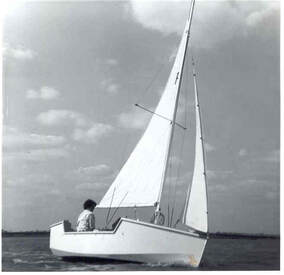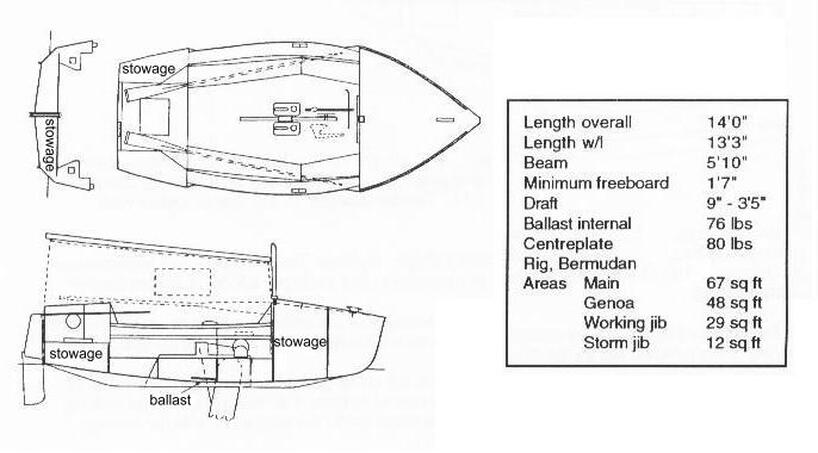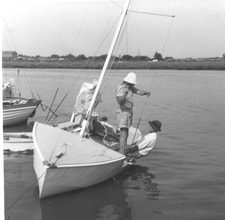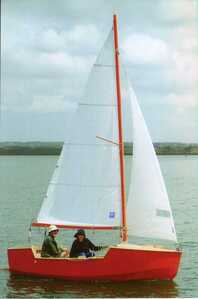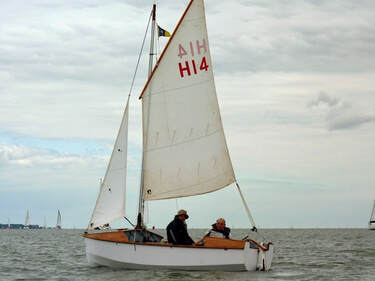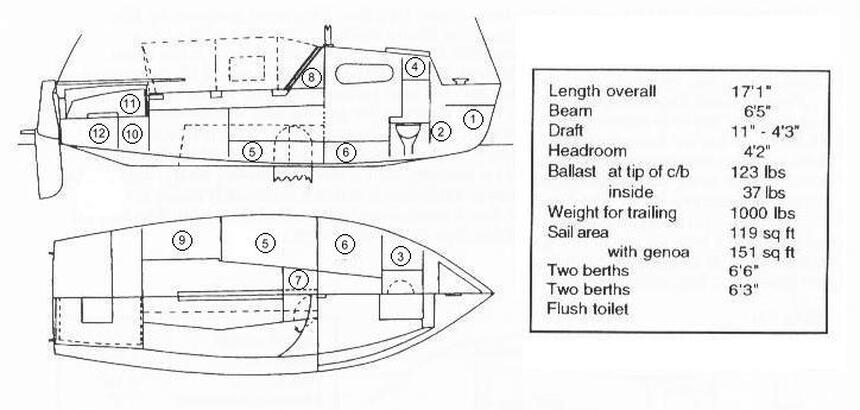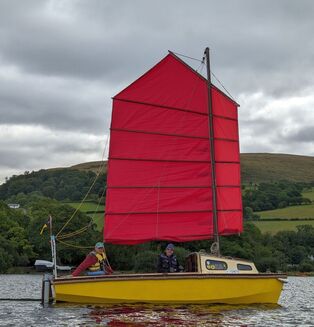The Roamer and Rebell Sailing Dinghies
|
These two cruising dinghies were designed by Eric Coleman who was responsible for the ideas that finally resulted in the birth of the DCA. He described his design principles in detail in DCA Bulletin numbers 56 and 57 which were published in 1972, as well as in his book Dinghies for all Waters published in 1976. As he says in the book: "Although a seaworthy dayboat will make an excellent cruising dinghy, it is not unreasonable to suppose that a dinghy designed specifically for cruising would be even more efficient." Coleman felt that if specially designed for the purpose, there was no reason why a fast close-winded boat shouldn't be produced which is also dry, stable and self-righting. |
After Eric's death his wife, Maureen, generously made the plans for both Roamer and Rebell over to the DCA and since then they have been available to purchase from the DCA Technical Advisor. The plans come with a materials list and instructions for building, which can be followed easily even if you have not built a boat before. Both sets of plans are now available in printed and pdf format and can be ordered by following the link at the end of the boat's description below. Price information can be found on the order pages.
To find out more about the two boats and Eric's design principles, please read on and download the attached articles.
To find out more about the two boats and Eric's design principles, please read on and download the attached articles.
THE ROAMER
|
The primary aim of the design is to stay upright and this was demonstrated during a stability test where two people with a combined weight of 152 kg stood on the sidedeck with the centreplate up and the gunwale was still above water. In addition to this stability, the boat will right herself when heeled over beyond 110 degrees from the vertical. Essentially she is designed to look after the crew when they make mistakes in handling her. |
The underwater lines of the Roamer are related to the fastest racing dinghies and it takes a racing dinghy to get the better of her. For sailing in shallow water the plate can be fully raised with negligible change in handling characteristics. Liveliness of handling is deliberately restrained so that the crew can make long passages without exhaustion. For day sailing there is plenty of room for four and the forward compartment can be used as a mini-cabin for children if it rains. The stability allows the crew to sit in the boat if they wish.
|
The layout for cruising shows that there is ample space for gear in watertight compartments and below the bottom boards. The aft section of the side benches are removable for sleeping aboard and one of them fits across the boat forward for use as a rowing thwart. When the awning is set, the oars are stowed as shown to push out the sides and give more room. There is no need to lower the mast when anchored in gale force winds.
If an outboard (long shaft) is carried, it can be stowed on the aft deck. if you intend to cruise in Roamer, try the boat out before buying an outboard. You will probably find that it is not required. Construction is orthodox plywood although the hull is thicker than usual at 5/16” to stand rough treatment. Building instructions and plans leave the builder nothing to work out for himself. All the parts are fully listed together with suppliers’ addresses. |
|
Here are two of the original articles written by Eric Coleman about how he designed Roamer: A Self-Righting Uncapsizable Cruising Dinghy Part II Bulletin 56, p.5 1972 A Self-Righting Uncapsizable Cruising Dinghy Part III Bulletin 57, p.6 1972 This article written by Peter Bick, former DCA Technical Advisor, is about the Roamer that he built and sailed for many years: My Roamer Bulletin 150, p.31 1996 |
THE REBELL
1 Bow Stowage |
2 Anchor Stowage |
3 Galley |
4 Lockers |
5 Clothes stowage |
6 Buoyancy bag |
7 Stowage under bridge deck |
8 Permanent hood / canvas cabin |
9 Lockers |
10 Outboard stowage |
11 Tender stowage |
12 Large locker with watertight hatch |
The Rebell was designed to encourage family dinghy cruising. The versatility and performance of a dinghy are retained but the facilities and protection of a yacht are added. A rubber dinghy can be carried in the stern.
The layout consists of a stowage shelf and stowage for the anchor in the bow. Aft of this the cabin has two 6’ 3” quarter berths with stowage under, flushing toilet under the forehatch and galley. The cabin floor is unobstructed. The cockpit can be covered by a canvas cabin, set on hoops, stowed against the aft side of the fore cabin, permanently attached to it. Side seats extend to form 6’ 6” berths with large lockers below. Aft is an open locker for the outboard. Stowage under the bottom boards for another anchor and under sidedecks for air beds, oars etc.
The crew can sit in the boat or on sidedecks to give greater sail carrying power. This boat has great ability to get to windward in a seaway. Off the wind she will plane if desired. The masthead rig enables a large spinnaker to be carried.
The layout consists of a stowage shelf and stowage for the anchor in the bow. Aft of this the cabin has two 6’ 3” quarter berths with stowage under, flushing toilet under the forehatch and galley. The cabin floor is unobstructed. The cockpit can be covered by a canvas cabin, set on hoops, stowed against the aft side of the fore cabin, permanently attached to it. Side seats extend to form 6’ 6” berths with large lockers below. Aft is an open locker for the outboard. Stowage under the bottom boards for another anchor and under sidedecks for air beds, oars etc.
The crew can sit in the boat or on sidedecks to give greater sail carrying power. This boat has great ability to get to windward in a seaway. Off the wind she will plane if desired. The masthead rig enables a large spinnaker to be carried.
|
A shortened version of keel and deadwood is incorporated to give steadiness on the helm. Halyards can be reached from the cockpit as in open boats, or from the forehatch in the top of the cuddy. Rebell is designed for pottering off the beaten track. With no keels to bite into the mud when going aground she can be floated off within five minutes. She will tack to windward in shallow water with the plate up. Although the hull is 5/16” ply, waterline and below are strengthened by veneers to give a total thickness of 7/16”. All internal construction including c/b case is finished and faired before the skin is fitted. This ensures all bulkheads are watertight.
|
|
Here are some articles that were published about the Rebell in the DCA Bulletin:
|
The friendly club with a sense of adventure. For all sailors who use boats for more than just racing.
|
© 2010-2024 DCA. All Rights Reserved. |
|

